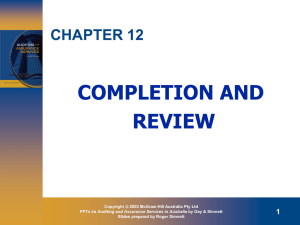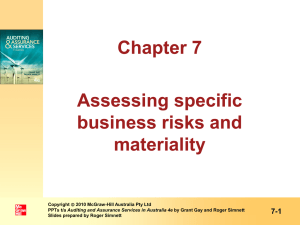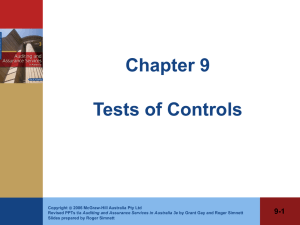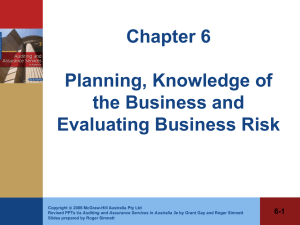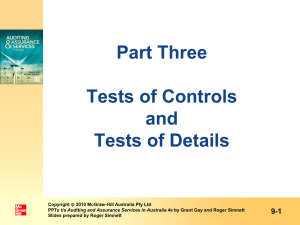Chapter 12
advertisement
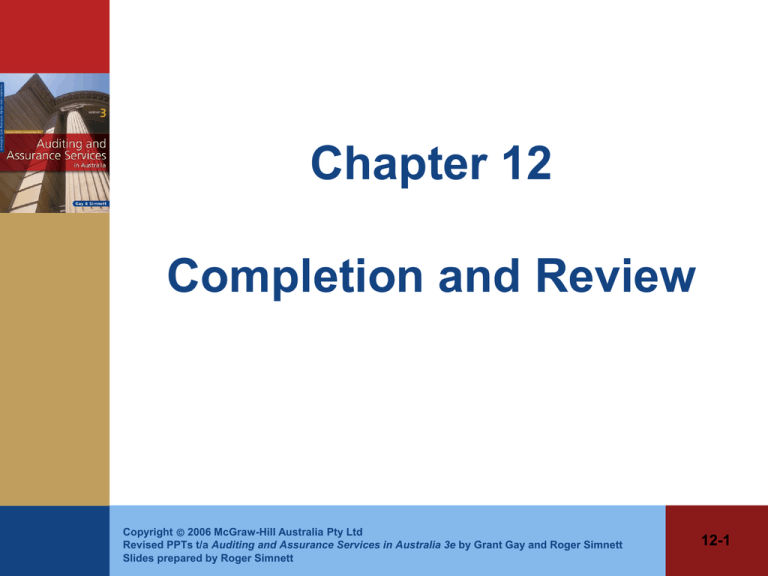
Chapter 12 Completion and Review Copyright 2006 McGraw-Hill Australia Pty Ltd Revised PPTs t/a Auditing and Assurance Services in Australia 3e by Grant Gay and Roger Simnett Slides prepared by Roger Simnett 12-1 The nature of completion and review procedures Copyright 2006 McGraw-Hill Australia Pty Ltd Revised PPTs t/a Auditing and Assurance Services in Australia 3e by Grant Gay and Roger Simnett Slides prepared by Roger Simnett 12-2 Learning Objective 1: Date of the Audit Report Important because it establishes date of auditor’s responsibility for knowledge of events that should be reflected in the financial report. • Audit report should be dated when it is actually signed, and no earlier than date of directors’ declaration. • Ensures financial report was completed and formally accepted by officers of company prior to auditor expressing an opinion. • Copyright 2006 McGraw-Hill Australia Pty Ltd Revised PPTs t/a Auditing and Assurance Services in Australia 3e by Grant Gay and Roger Simnett Slides prepared by Roger Simnett 12-3 Audit procedures after balance date • Many audit procedures performed after balance date as normal tests of balances, e.g.: – – – cutoff tests; collectability of accounts receivable determined by subsequent payment; and search for unrecorded liabilities. Copyright 2006 McGraw-Hill Australia Pty Ltd Revised PPTs t/a Auditing and Assurance Services in Australia 3e by Grant Gay and Roger Simnett Slides prepared by Roger Simnett 12-4 Analytical procedures after balance date • Auditor is also required to apply analytical procedures at or near completion of the audit to: – – – assist in overall review of reasonableness of financial report; ensure financial report is consistent with auditor’s knowledge of entity; and corroborate conclusions formed during audit. Copyright 2006 McGraw-Hill Australia Pty Ltd Revised PPTs t/a Auditing and Assurance Services in Australia 3e by Grant Gay and Roger Simnett Slides prepared by Roger Simnett 12-5 Learning Objective 2: Subsequent Events Review • AASB 110 (IAS 10) indicates that financial reports should reflect the effects of certain events occurring up to time of completion (defined as date of directors’ declaration or approval of financial report by owners or controlling management). • Auditor’s responsibility to consider subsequent events is extended up to the date on which auditor signs the audit report. Refer AUS 706/ASA 560 (ISA 560). Copyright 2006 McGraw-Hill Australia Pty Ltd Revised PPTs t/a Auditing and Assurance Services in Australia 3e by Grant Gay and Roger Simnett Slides prepared by Roger Simnett 12-6 Types of Events Subsequent to Balance Date • Two types of events may materially affect financial reports. These are: – – Type 1 or adjusting events Type 2 or disclosing events. Copyright 2006 McGraw-Hill Australia Pty Ltd Revised PPTs t/a Auditing and Assurance Services in Australia 3e by Grant Gay and Roger Simnett Slides prepared by Roger Simnett 12-7 Type 1 or Adjusting Events • Events, both favourable and unfavourable, that provide evidence of, or further elucidate conditions that existed at balance date. • Financial effect of such events need to be brought to account (amounts in the financial statements need to be adjusted). Copyright 2006 McGraw-Hill Australia Pty Ltd Revised PPTs t/a Auditing and Assurance Services in Australia 3e by Grant Gay and Roger Simnett Slides prepared by Roger Simnett 12-8 Examples of Adjusting Events • Subsequent collection of a material account receivable that has been treated as uncollectable at balance date. • A commercial assessment or legal determination, subsequent to balance date, that establishes definitively a claim that was in existence, but of an uncertain amount, at balance date. Copyright 2006 McGraw-Hill Australia Pty Ltd Revised PPTs t/a Auditing and Assurance Services in Australia 3e by Grant Gay and Roger Simnett Slides prepared by Roger Simnett 12-9 Type 2 or Disclosing Events • Do not relate to a condition that existed at balance date; • Include both favourable and unfavourable events that create new conditions, as distinct from any condition that might have existed at balance date; • If material, disclose in the notes to the accounts. Copyright 2006 McGraw-Hill Australia Pty Ltd Revised PPTs t/a Auditing and Assurance Services in Australia 3e by Grant Gay and Roger Simnett Slides prepared by Roger Simnett 12-10 Examples of Type 2 Events • A fire or flood loss after balance date, not fully covered by insurance; • Raising of additional shares or loan capital after balance date; and • Mergers and acquisitions after balance date. Copyright 2006 McGraw-Hill Australia Pty Ltd Revised PPTs t/a Auditing and Assurance Services in Australia 3e by Grant Gay and Roger Simnett Slides prepared by Roger Simnett 12-11 Events Between Balance Date and Date of Audit Report • The auditor has a responsibility to apply audit procedures sufficient to enable auditor to determine whether all material Type 1 and Type 2 events have been appropriately adjusted for (Type 1) or disclosed (Type 2) in the financial report, up until the date of the audit report. Copyright 2006 McGraw-Hill Australia Pty Ltd Revised PPTs t/a Auditing and Assurance Services in Australia 3e by Grant Gay and Roger Simnett Slides prepared by Roger Simnett 12-12 Events subsequent to the date of the audit report • Auditor has no responsibility to seek audit evidence to identify such events. • Where auditor becomes aware of events that have a material effect on financial report and the report has not yet been issued (sent to shareholders), auditor should discuss the matter with management and seek to have an amended financial report issued. Copyright 2006 McGraw-Hill Australia Pty Ltd Revised PPTs t/a Auditing and Assurance Services in Australia 3e by Grant Gay and Roger Simnett Slides prepared by Roger Simnett 12-13 Events subsequent to the issue of the financial report If material events come up or are brought to auditor’s attention after financial report has been sent to shareholders, auditor should discuss matter with management. • Where decision made to issue new financial report, auditor should perform procedures necessary to form an opinion on revised financial report. • Auditor should take steps to prevent reliance on superseded financial report and audit report. • Copyright 2006 McGraw-Hill Australia Pty Ltd Revised PPTs t/a Auditing and Assurance Services in Australia 3e by Grant Gay and Roger Simnett Slides prepared by Roger Simnett 12-14 Learning Objective 3: Representation Letters • Two types of letters are commonly sought towards completion of audit: – – Solicitor's Management Copyright 2006 McGraw-Hill Australia Pty Ltd Revised PPTs t/a Auditing and Assurance Services in Australia 3e by Grant Gay and Roger Simnett Slides prepared by Roger Simnett 12-15 Solicitors’ representation letter • Auditor should obtain letter from solicitors consulted by the client during the year to obtain evidence on existence, completeness, valuation and presentation of legal issues identified during audit. • All enquiries of legal representatives of clients, and their responses to these enquiries (representations) will be documented in this representation letter. • Example representation letter contained at Exhibit 12.2 (pp. 570-571) Copyright 2006 McGraw-Hill Australia Pty Ltd Revised PPTs t/a Auditing and Assurance Services in Australia 3e by Grant Gay and Roger Simnett Slides prepared by Roger Simnett 12-16 Management representation letter • A written representation letter, prepared by auditor and signed by management, which formalises management responses to inquiries made by auditor during audit, and also clarifies management’s responsibilities. Copyright 2006 McGraw-Hill Australia Pty Ltd Revised PPTs t/a Auditing and Assurance Services in Australia 3e by Grant Gay and Roger Simnett Slides prepared by Roger Simnett 12-17 Reliability of management representation letter • Limited in its reliability as audit evidence, and is usually used to corroborate other evidence (should not replace other evidence gathered by auditor). • Might be the only (primary) evidence available to support management’s intentions of future actions. • Example contained at Exhibit 12.3 (pp. 574-575). Copyright 2006 McGraw-Hill Australia Pty Ltd Revised PPTs t/a Auditing and Assurance Services in Australia 3e by Grant Gay and Roger Simnett Slides prepared by Roger Simnett 12-18 Learning Objective 4: Review of working papers and financial report • Undertaken at end of the engagement as a final check to ensure that all significant matters and problems have been identified, considered and satisfactorily resolved. • Must consider size and nature of errors, as they might affect risk assessment and audit testing. • Immaterial errors identified during audit may be considered material when aggregated, and thus require adjustment. Copyright 2006 McGraw-Hill Australia Pty Ltd Revised PPTs t/a Auditing and Assurance Services in Australia 3e by Grant Gay and Roger Simnett Slides prepared by Roger Simnett 12-19 Review of the financial report In considering presentations and disclosures for each account balance and related note disclosures, the auditor must gather evidence to support the following assertions: (i) Occurrence and rights and obligations - disclosed events, transactions and other matters have occurred and pertain to the entity; (ii) Completeness - all disclosures that should have been included in the financial report have been included (iii) Classification and understandability – financial; information is appropriately presented and described and disclosures are clearly expressed; (iv) Accuracy and valuation - financial and other information is disclosed fairly and at appropriate amounts. Copyright 2006 McGraw-Hill Australia Pty Ltd Revised PPTs t/a Auditing and Assurance Services in Australia 3e by Grant Gay and Roger Simnett Slides prepared by Roger Simnett 12-20 Review of the financial report (Cont.) • Having collected evidence on other assertions related to account balances and classes of transactions, auditor will ensure that disclosures are fairly represented. • Auditor will further ensure that the financial information is appropriately classified and is understandable. • Auditor should also ensure that their name is not associated with misleading information. • Auditor should finally ‘step back’ and ensure that the view presented by the financial report and all associated information is consistent with the underlying state of affairs. Copyright 2006 McGraw-Hill Australia Pty Ltd Revised PPTs t/a Auditing and Assurance Services in Australia 3e by Grant Gay and Roger Simnett Slides prepared by Roger Simnett 12-21 Review of other information contained in annual report • Other information in annual report is not part of the financial report and is not covered by the audit report, e.g. directors’ report. • Auditor should review other information to identify: – – • Material inconsistencies with financial report; and Misstatements of fact Auditor who identifies a material inconsistency or misstatement of fact needs to determine whether the audited financial report or the other information needs to be amended. Copyright 2006 McGraw-Hill Australia Pty Ltd Revised PPTs t/a Auditing and Assurance Services in Australia 3e by Grant Gay and Roger Simnett Slides prepared by Roger Simnett 12-22 Learning Objective 5: Appropriateness of the Going Concern Basis • As well as assessing risk of going concern problems at planning stage, AUS 708/ASA 570 (ISA 570) requires auditor to assess once more at final review stage in order to confirm appropriateness of going concern principle as a basis for preparing financial report. • If not clear that going concern basis is appropriate, additional audit procedures might be necessary. Copyright 2006 McGraw-Hill Australia Pty Ltd Revised PPTs t/a Auditing and Assurance Services in Australia 3e by Grant Gay and Roger Simnett Slides prepared by Roger Simnett 12-23 Assessing going concern at completion stage • Additional procedures include: – – – – – Review events occurring after balance date Analyse latest interim financial report Read minutes of meetings Review terms of loan agreements Consider information from entity’s solicitors Copyright 2006 McGraw-Hill Australia Pty Ltd Revised PPTs t/a Auditing and Assurance Services in Australia 3e by Grant Gay and Roger Simnett Slides prepared by Roger Simnett 12-24 Comfort Letters • Auditor needs to confirm arrangements made with third parties concerning provision of additional finance to support audited entity, and the capacity of the third party to provide promised support. • Often a parent entity will support subsidiary in financial difficulty: – – Letter of support: parent agrees to provide financial assistance to subsidiary for fixed period. Letter of subordination: parent agrees not to demand repayment of financial debts owed by subsidiary. Copyright 2006 McGraw-Hill Australia Pty Ltd Revised PPTs t/a Auditing and Assurance Services in Australia 3e by Grant Gay and Roger Simnett Slides prepared by Roger Simnett 12-25
